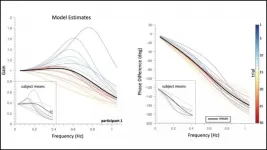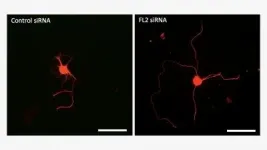New algorithm uses online learning for massive cell data sets
The method enables researchers to analyze millions of cells with the amount of memory found on a standard computer
2021-04-19
(Press-News.org) The fact that the human body is made up of cells is a basic, well-understood concept. Yet amazingly, scientists are still trying to determine the various types of cells that make up our organs and contribute to our health.
A relatively recent technique called single-cell sequencing is enabling researchers to recognize and categorize cell types by characteristics such as which genes they express. But this type of research generates enormous amounts of data, with datasets of hundreds of thousands to millions of cells.
A new algorithm developed by Joshua Welch, Ph.D., of the Department of Computational Medicine and Bioinformatics, Ph.D. candidate Chao Gao and their team uses online learning, greatly speeding up this process and providing a way for researchers world-wide to analyze large data sets using the amount of memory found on a standard laptop computer. The findings are described in the journal Nature Biotechnology.
"Our technique allows anyone with a computer to perform analyses at the scale of an entire organism," says Welch. "That's really what the field is moving towards."
The team demonstrated their proof of principle using data sets from the National Institute of Health's Brain Initiative, a project aimed at understanding the human brain by mapping every cell, with investigative teams throughout the country, including Welch's lab.
Typically, explains Welch, for projects like this one, each single-cell data set that is submitted must be re-analyzed with the previous data sets in the order they arrive. Their new approach allows new datasets to the be added to existing ones, without reprocessing the older datasets. It also enables researchers to break up datasets into so-called mini-batches to reduce the amount of memory needed to process them.
"This is crucial for the sets increasingly generated with millions of cells," Welch says. "This year, there have been five to six papers with two million cells or more and the amount of memory you need just to store the raw data is significantly more than anyone has on their computer."
Welch likens the online technique to the continuous data processing done by social media platforms like Facebook and Twitter, which must process continuously-generated data from users and serve up relevant posts to people's feeds. "Here, instead of people writing tweets, we have labs around the world performing experiments and releasing their data."
The finding has the potential to greatly improve efficiency for other ambitious projects like the Human Body Map and Human Cell Atlas. Says Welch, "Understanding the normal compliment of cells in the body is the first step towards understanding how they go wrong in disease."
INFORMATION:
Paper cited: "Iterative single-cell multi-omic integration using online learning," Nature Biotechnology. DOI: https://doi.org/10.1038/s41587-021-00867-x
ELSE PRESS RELEASES FROM THIS DATE:
2021-04-19
A lot about the human brain and its intricacies continue to remain a mystery. With the advancement of neurobiology, the pathogenesis of several neurodegenerative diseases (ND) has been uncovered to a certain extent along with molecular targets around which current therapies revolve. However, while the current treatments offer temporary symptomatic relief and slow down the course of the disease, they do not completely cure the condition and are often accompanied by a myriad of side effects that can impair normal daily functions of the patient.
Light stimulation has been proposed as a promising therapeutic alternative for treating various ND like ...
2021-04-19
The brain's auditory system tracks the speed and location of moving sounds in the same way the visual system tracks moving objects. The study recently published in eNeuro lays the groundwork for more detailed research on how humans hear in dynamic environments.
People who use hearing aids have trouble discriminating sounds in busy environments. Understanding if and how the auditory system tracks moving sounds is vital to improving hearing aid technology. Prior research utilizing eye movements to gauge whether the brain is following the trajectory of a moving sound indicates it cannot. A new study from García-Uceda Calvo et al. instead used head movements, a more accurate measure of sound tracking.
The team analyzed head movements of hearing ...
2021-04-19
April 19, 2021--(BRONX, NY)--Researchers at Albert Einstein College of Medicine have developed a topical drug that regenerates and restores the function of erectile nerves damaged by radical prostatectomy, the most common treatment for localized prostate cancer. The drug was tested in rats, and the findings were published online today in JCI Insight.
"Erectile dysfunction (ED) after radical prostatectomy has a major impact on the lives of many patients and their partners," said study co-leader David J. Sharp, Ph.D., professor of physiology & biophysics and of ophthalmology and visual sciences and professor in the Dominick P. Purpura Department of Neuroscience at Einstein. "Since rats are reliable animal models in urologic research, our drug offers real hope of normal sexual ...
2021-04-19
DALLAS - April 19, 2021 - Treating people with Type 2 diabetes with a new once-a-week injectable insulin therapy proved to be safe and as effective as daily insulin injections, according to the results of two international clinical trials published online today in Diabetes Care. The studies suggest that the once-weekly treatment could provide a convenient alternative to the burden of daily insulin shots for diabetes patients.
Starting and maintaining insulin treatment remain a challenge for millions of patients worldwide with Type 2 diabetes. Fear of injections and the inconvenience and burden of injectable therapy contribute to the barriers against insulin therapy initiation and adherence. The effectiveness and safety of ongoing insulin treatment are also highly dependent ...
2021-04-19
Data from a GPS network in Colombia have revealed a shallow and fully locked part on the Caribbean subduction zone in the country that suggests a possible large earthquake and tsunami risk for the northwest region.
The locked patch south of Cartagena city is capable of generating a magnitude 8.0 earthquake every 600 years, said Sindy Lizarazo of Nagoya University in Japan, who presented the study at the Seismological Society of America (SSA)'s 2021 Annual Meeting.
Colombia lies in the middle of a complex tectonic zone, where the Caribbean, Nazca and South American tectonic plates and other smaller tectonic blocks converge. The Caribbean plate ...
2021-04-19
Boston College seismologist John Ebel and his colleagues have noted a pattern for some large California earthquakes: magnitude 4 or larger earthquakes occur at a higher rate along a fault in the two decades or more prior to a magnitude 6.7 or larger earthquake on the fault.
The findings prompted Ebel in 2017 to suggest a prospective test. He looked for the California faults that had magnitude 4 or larger earthquakes occurring at a rate higher than 0.5 earthquakes per year from 1997 to 2016. If the pattern holds, the next magnitude 6.7 earthquakes in California are most likely to ...
2021-04-19
Eighteen minutes might be all it takes to ensure a full recovery for stroke patients in rural South Carolina.
By changing EMS workflows and incorporating telemedicine techniques, physicians at MUSC Health have partnered with Georgetown Memorial Hospital and Hampton Regional Medical Center to significantly shorten the time between a patient's stroke symptom onset and their treatment, as recently reported in the Journal of Stroke and Cerebrovascular Diseases.
Through MUSC Health's Telestroke Network, emergency medical technicians (EMTs) can video chat with stroke specialists to begin a patient's consult before they even arrive at the hospital. ...
2021-04-19
A new study finds a naturally occurring "earthquake gate" that decides which earthquakes are allowed to grow into magnitude 8 or greater.
Sometimes, the "gate" stops earthquakes in the magnitude 7 range, while ones that pass through the gate grow to magnitude 8 or greater, releasing over 32 times as much energy as a magnitude 7.
"An earthquake gate is like someone directing traffic at a one-lane construction zone. Sometimes you pull up and get a green 'go' sign, other times you have a red 'stop' sign until conditions change," said UC Riverside geologist Nicolas Barth.
Researchers learned about this gate while studying New Zealand's Alpine ...
2021-04-19
April 19, 2021 - At the current rate of change, it will take more than 200 years for the proportion of women in orthopaedic surgery to reach parity with the overall medical profession, according to a study in Clinical Orthopaedics and Related Research® (CORR®), a publication of The Association of Bone and Joint Surgeons®. The journal is published in the Lippincott portfolio by Wolters Kluwer.
"Substantive changes must be made across all levels of orthopaedic education and leadership to steepen the current curve," concludes the report by Atul F. Kamath, MD, of the Cleveland Clinic Foundation and colleagues. "Our findings support the need for changes in medical schools, orthopaedic residency ...
2021-04-19
Inside your body, cell movement plays a crucial role in many significant biological processes, including wound healing, immune responses and the potential spread of cancer.
"Most people don't die from having a primary tumor," said Kolade Adebowale, a graduate student in chemical engineering, and a member of the Chemical Biology Interface (CBI) graduate program in Chemistry, Engineering & Medicine for Human Health (ChEM-H) at Stanford University. "The problem is when cancer cells from the tumor acquire the ability to metastasize or move to different parts ...
LAST 30 PRESS RELEASES:
[Press-News.org] New algorithm uses online learning for massive cell data sets
The method enables researchers to analyze millions of cells with the amount of memory found on a standard computer




